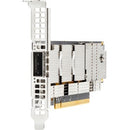Description
HPE InfiniBand NDR 1-port OSFP PCIe5 x16 MCX75310AAS-NEAT Adapter
Discover unmatched performance for your next-generation HPC, AI, and data analytics workloads with the HPE InfiniBand NDR 1-port OSFP PCIe5 x16 MCX75310AAS-NEAT Adapter. Engineered for ultra-low latency and extraordinary bandwidth, this single-port InfiniBand adapter combines cutting-edge PCIe Gen5 connectivity with an OSFP port so you can scale your clusters without compromise. Built to support the most demanding compute environments, it delivers the speed and efficiency needed to accelerate scientific simulations, large-scale machine learning, and real-time data processing. With NVIDIA In-Network Computing engines, the MCX75310AAS-NEAT integrates compute-forward capabilities directly into the network fabric, reducing CPU overhead and enabling smarter, faster data workflows across your HPC infrastructure. If your goal is to maximize throughput while keeping latency predictable, this adapter is designed to meet the mission-critical needs of modern data centers and research labs.
- Ultra-low latency with maximum throughput: HPE InfiniBand NDR adapters are purpose-built for deterministic, low-latency communication and up to 400 Gb/s throughput per port, delivering the responsiveness required for tightly coupled HPC workloads and time-sensitive AI inference.
- PCIe Gen5 x16 host interface with an OSFP port: The PCIe 5.0 x16 connection, paired with a high-speed OSFP port, provides ample headroom for peak performance, enabling expansive node density and sustained bandwidth across large clusters.
- NVIDIA In-Network Computing engines: Offload complex compute tasks to the network, accelerating distributed ML training, graph analytics, and large-scale simulations while freeing CPU cycles for other critical processes.
- Single-port, scalable InfiniBand connectivity: The 1-port OSFP design supports flexible deployment in dense server configurations, enabling scalable fabric expansion without sacrificing efficiency or footprint.
- Enterprise-grade software and ecosystem support: Robust Linux driver support, mature management tools, and compatibility with common HPC software stacks ensure smooth integration into existing environments and straightforward cluster administration.
Technical Details of HPE InfiniBand NDR 1-port OSFP PCIe5 x16 MCX75310AAS-NEAT Adapter
- Product name: HPE InfiniBand NDR 1-port OSFP PCIe5 x16 MCX75310AAS-NEAT Adapter
- Port count: 1 InfiniBand NDR port (OSFP form factor)
- Data rate: Up to 400 Gb/s throughput per port
- Host interface: PCIe Gen5 x16
- Form factor: OSFP network port on a PCIe expansion card
- Protocols: InfiniBand (IB), RDMA-enabled workflows, NVIDIA In-Network Computing integration
- Operating system and drivers: Linux-based HPC environments with supported drivers from HPE/NVIDIA
- Target use cases: High-performance computing, scientific simulations, AI model training at scale, data analytics, and real-time data processing
How to install HPE InfiniBand NDR 1-port OSFP PCIe5 x16 MCX75310AAS-NEAT Adapter
Installing this adapter in a compatible server is straightforward and designed to minimize downtime in data centers with large-scale compute nodes. Follow these steps to ensure a proper, reliable setup and optimal performance:
- Power down the server and unplug all power sources. Open the chassis and locate an available PCIe 5.0 x16 expansion slot suitable for a mezzanine-style NIC card or full-height PCIe card depending on your server model.
- Remove the slot cover, align the MCX75310AAS-NEAT adapter with the PCIe slot, and firmly seat the card into the slot. Secure the bracket to the chassis to prevent movement during operation.
- Reattach any required power connectors if your server design uses auxiliary power for PCIe devices. Ensure proper cable management so airflow remains unobstructed.
- Boot the server and install the latest HPE/NVIDIA InfiniBand drivers and firmware. This typically involves downloading the appropriate Linux driver package from the HPE/NVIDIA support portals and following the installation instructions provided in the release notes.
- Connect the InfiniBand OSFP transceiver/cable to the adapter’s OSFP port and verify physical link stability. Use in-band or out-of-band management tools to confirm the device is recognized by the system and that the InfiniBand fabric topology is healthy.
- Configure the InfiniBand network: initialize the Subnet Manager (SM) if needed, assign GUIDs, set up partitioning (if required), and enable RDMA-enabled workflows. Validate performance with standard bandwidth and latency tests (for example, ibstat, ibv_devinfo, and iperf3-based benchmarks) and adjust flow control and buffer settings for your workload mix.
- Integrate with your cluster management tooling and workload schedulers. Ensure that your MPI (Message Passing Interface) environment or other distributed compute frameworks are configured to utilize RDMA and InfiniBand transport to take full advantage of the NDR capabilities and In-Network Computing offloads.
Frequently asked questions
-
Q: What does NDR signify in this HPE InfiniBand adapter?
A: NDR stands for Next-Generation Data Rate InfiniBand, a performance tier focused on maximizing data throughput and minimizing latency to support demanding HPC and data-centric workloads.
-
Q: How many ports does this adapter provide?
A: The MCX75310AAS-NEAT is a single-port InfiniBand adapter with an OSFP connector designed for high-density deployments.
-
Q: What kind of performance can I expect?
A: You can expect up to 400 Gb/s throughput per port with ultra-low latency to meet the needs of large-scale HPC clusters, real-time analytics, and AI training pipelines.
-
Q: Which systems and software are supported?
A: This adapter is designed for Linux-based HPC environments and is supported by HPE/NVIDIA drivers and management tools. It integrates with common cluster schedulers and MPI implementations for scalable workloads.
-
Q: How does NVIDIA In-Network Computing benefit my workloads?
A: In-Network Computing offloads certain computations to the network fabric, reducing CPU overhead and accelerating distributed tasks such as large-scale ML inference, graph processing, and data analytics during data movement.
-
Q: How should I plan for deployment in a data center?
A: Plan for PCIe 5.0 x16 bandwidth, adequate cooling, and fabric planning with a Subnet Manager. Consider updating firmware and drivers to the latest versions, and validate network performance with representative workloads before production rollout.
Customer reviews
Showing - Of Reviews


